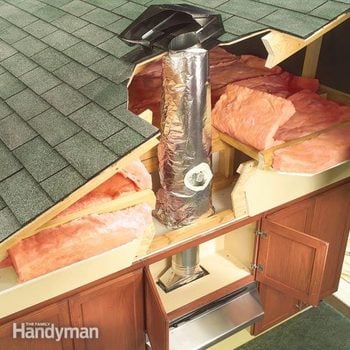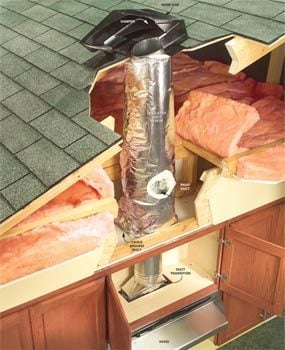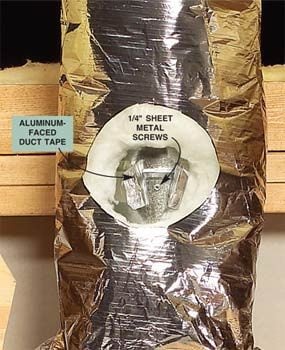New Kitchen Venting: How to Install a Kitchen Fan Vent
Updated: Mar. 01, 2023Use rigid duct with insulated duct sleeve for an oven exhaust fan.

- Time
- Complexity
- Cost
- A full day
- Intermediate
- $51–100
How to install a new kitchen fan vent
If you want to replace the range hood and exhaust fan above your stove and vent it to the outside, and the stove is against an interior wall, you have several options. But the rule of thumb is to route it the shortest and straightest path to daylight. That way, you’ll get the best airflow and the least amount of grease buildup for your kitchen fan vent.
From the inside wall of a ranch house (one level), that route usually means going up through the attic and out the roof. You could also go up into the cabinet above the stove—then horizontally to the closest exterior wall, either through the cabinets or in the area above the cabinets. Unfortunately, running the vent that way eats up valuable cabinet space, and it can be tricky to install, especially if you attempt to run it in the soffit area because of obstacles.
Whichever route you choose, make sure the total duct length doesn’t exceed the fan capacity. The owner’s manual will usually tell you specifics on duct sizes and lengths. First, plan your route. The safest way to check the attic directly above the stove is to chuck an 18-in. section of straightened coat hanger into a drill. Loosely hold the wire and direct it through the ceiling drywall approximately where your vent pipe will go.
Go up in the attic, find the coat hanger and push insulation aside to make sure there are no joists, electrical wiring or other building materials that might block a 6-in. hole. Then examine the roof directly above the wire to make sure there’s room to install a roof vent. Drop a plumb bob down from the roof to the wire so you can find the approximate roof exit location. You may have to shift the vent position several inches to avoid ceiling and roof framing.
Back in the kitchen, mark the cabinets and cut holes for the ducts. Attach all ductwork, then go up to the attic and reposition the plumb bob so it drops straight into the middle of the pipe coming up from the kitchen. Cut the hole for the duct, attach it, then install the roof cap.
If you live in an area where frost occurs, add an insulated duct sleeve to the portion of pipe in the attic. Screw the ductwork together with 1/4-in. sheet metal screws and seal the seams with aluminum-faced duct tape (not regular, cloth-backed duct tape).
Finally, install the hood. Attach the transition duct to the hood and make sure the damper flap operates freely. Lift the hood into place and attach it to the wall. Then caulk around the vent pipe where it enters the ceiling.
Required Tools for this Kitchen Fan Vent Project
Have the necessary tools for this DIY project lined up before you start—you’ll save time and frustration.
- Caulk gun
- Cordless drill
- Dust mask
- Extension cord
- Jigsaw
- Tape measure
- Tin snips
- Utility knife
Required Materials for this Kitchen Fan Vent Project
Avoid last-minute shopping trips by having all your materials ready ahead of time. Here’s a list.
- 1/4-in. sheet metal screws
- Aluminum faced duct tape
- Caulk
- Duct transition
- Insulated duct sleeve
- Rigid duct
- Roof cap


